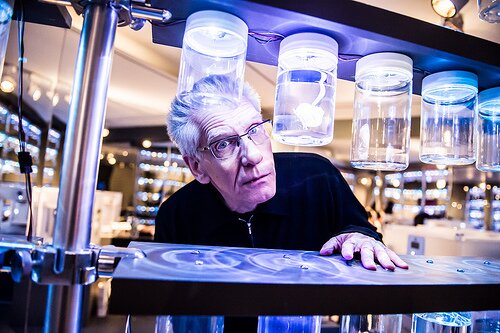The scariest thing in a David Cronenberg film isn’t the chilling body-horror practical effects or the strangely stilted performances. It’s the long, awkward stretches of quiet.
Watch Naked Lunch, Scanners, or The Dead Zone and pay attention to the background music or lack thereof. A Cronenberg film doesn’t need to rely on creepy strings or jump-scare stings. More so than anyone in our series so far – yes, even Jordan Peterson – Cronenberg’s films are distillations of the nihilistic, the amoral, and the meaningless, presented (for the most part) without ornamentation.
There is blood, and there is gore, and there are transformations into fly-men, and all of these are great selling points for a film trailer. But these concessions to traditional horror are never the point of a Cronenberg film. The point is that the characters were already monsters, and the only thing that has changed is that now they look like monsters.
A Cronenberg film likely doesn’t have a hero, in the same way that Scott Pilgrim isn’t really a hero. Nikolai from Eastern Promises is a ruthless Russian mobster. Eric in Cosmopolisis a depraved capitalist whose life is consumed over the course of a limousine ride. Tom in A History of Violence starts off as a conventional family man hero whose past as a gangster catches up with him, causing him to murder his own brother (in self-defense). His characters don’t wonder how they got so messed up, and why the world around them is so messed up – they just accept it as a matter of course. They stare brokenly at the camera, often in stark close-up, growling and croaking out their lines as if under duress.
But Cronenberg is not content to merely portray the dark side of human nature. He has a bone to pick with reality itself. Long before Christopher Nolan played with the boundary between the real world and the worlds we create for ourselves with Inception, Cronenberg did it with eXistenz. Crash isn’t just a meditation on how far the bounds of human sexuality can be pushed – his characters actively appear to be drawn towards the singularity of transhumanist lore, where a woman grinding on an airplane’s fuselage and where the titular car crashes represent a melding of flesh and metal, to say nothing of the brainwashed, television-worshipping cultists in Videodrome who implant VCR cassettes into their chests and cry “All hail the new flesh!” Mad doctors, Fausts in 1980s power suits, play God in The Brood and Scanners.
And yet… are Cronenberg’s warped realities more authentic than reality itself? Is the world we encounter each day any less amoral and Darwinian than the ones in Cronenberg’s films? His characters do not let out slasher-movie screams or mug for the camera with wide-eyed expressions of terror, but neither do we, when perhaps we should. And to return to that damnable quiet, we are not cued with music or shaky-cam when something terrible is about to happen to us or someone we love. Addicts, like those in Naked Lunch, often look like respectable people. Abuse, like that in The Brood is often treated in a clinical manner, both by the doctor and by the victim. People deliberately and purposely distort their bodies and souls like in The Fly.
But wait a minute, isn’t this a series about Canadian culture? Of course it is. For within all of Cronenberg’s films – shot, deliberately in Canada as opposed to other big-budget films that are just there to take advantage of tax credits – is a portrayal of life without ideological struggle, religion, the clashing of grand historical forces or nations locked in war – the things that have defined America and make it special. Cronenberg is showing Canada as it truly is – a relativistic Sodom where everything is permitted, because nothing is true, or held to be absolutely true.
There are no grand Devil’s Pleasure Palaces, no monuments to sin in Cronenberg’s worlds. There is evil enough within the silent, awkward pauses of his conversations, for after all, is it not true that the greatest trick the Devil ever pulled was to convince the world that he didn’t exist?
Next week, we’ll revisit the absurdist side of Canadian humour with an analysis of Manitoba filmmaker Guy Maddin’s beer-soaked, black-and-white slapstick opus, The Saddest Music In The World.
********
Photo by Canadian Film Centre 
See the previous installments in the series:
Part 1 on Heroes: ‘Scott Pilgrim Vs The World’ Vs Terrance Denby and ‘Sidequest’
Part 2 on “Humour”: The Libertarian Fantasy of ‘Letterkenny’
Part 3 on Graphic Novel Nihilism: The Harsh Truths of ‘Essex County’
Part 4 on Spawn and Wolverine: Banished From The Promised Land: A Tale of Two Canadian Anti-Heroes
Part 5 on Science Fiction Dystopias: Inside Quebec’s – and Canada’s – Replicant Culture
Part 6 on Animation: The Garrison Mentality: More Than Meets The Eye
Part 7 on Pop Music: How To Build A Successful Canadian Musical Act
Part 8 on Anne of Green Gables and The Traumatized Artist: Lucy Maud Montgomery’s Treacherous Alpine Path
Part 9 on Avoiding the Serious: Mordecai Richler, Montreal, And Gritty Realism
Part 10 on Southern Ontario Gothic: The Marriage of the Mundane and the Fantastic
Part 11 on Margaret Atwood’s Reign of Terror: Literary Tyranny and The Handmaid’s Tale
Part 12 on the First Nations Fraud: Whitewashing Genocide: Truth, Lies, and Joseph Boyden
Part 13 on the inventive Esi Edugyan: A Novel I Cannot Recommend Enough
Part 14 on Generation X Origins: Douglas Coupland And The Hopeful (?) Future Of Canadian (?) Culture
Part 15 on Jordan Peterson Rising: Canadian Culture Creators And The Intellectual Dark Web



Comments
Leave a Reply